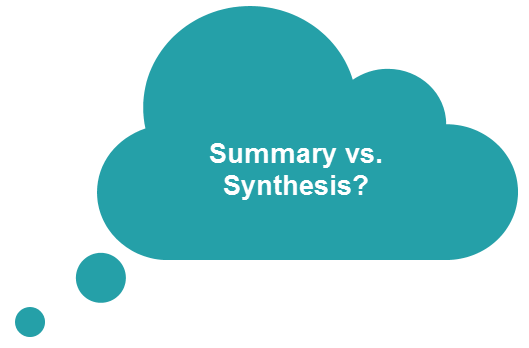After successfully conducting research for a project, you will find yourself facing a mass of information and wondering how you will sort it all out to write a paper. This sorting process is the focus of this section.
First, we will distinguish the demands of a synthesis project from a basic summary. And next, we will practice organizing the research material into relevant categories of discussion. Finally, we will develop a template to filter research material into these categories of discussion and, develop connections and commentary.
Note
This lesson draws on knowledge of three articles. If you haven’t already, you will want to read them now.
Jenkins, H. (2006). Confronting the challenges of participatory culture: Media education for the 21st century. An Occasional Paper on Digital Media and Learning. John D. and Catherine T. MacArthur Foundation. Retrieved from https://files.eric.ed.gov/fulltext/ED536086.pdf
Prensky, M. (2001). Digital natives, digital immigrants. On the Horizon, 9(5). Retrieved 5 October 2001, from http://www.marcprensky.com/writing/Prensky%20-%20Digital%20Natives,%20Digital%20 Immigrants%20-%20Part1.pdf
Wohlsen, M. (2016). Digital literacy is the key to the future, but we still don’t know what it means. WIRED. Retrieved 14 April 2016, from http://www.wired.com/2014/09/digital-literacy-key-future-still-don’t-know-means/
Understanding Synthesis

Let’s begin with what you don’t want to do in a synthesis paper. Working with research material is challenging, and the risk is that research material is summarized in the paper, but not synthesized.
What’s the difference?
| Summary of Research material in an essay | Synthesis of Research material in an essay |
|---|---|
| Source material is described in summary form, with an emphasis on how that material relates to the overall essay topic. | Source material is critically evaluated for the position it takes in the larger conversation about the topic. |
| Source material is treated independently, with little effort to find connections or relationships between sources. | Source material is viewed as part of a larger conversation, and explored for how it relates to and connects with the other sources addressing the same topic. |
| Summary essays are organized by source, as each section of the essay summarizes the ideas in one source. In this way, they are really essay versions of the annotated bibliography. | Synthesis essays are organized by key issues or categories of information, and each section works to illuminate a new understanding of the issue by combining a variety of sources and examining the connections among them. |
So, the goal when writing a synthesis paper is to find and explore meaningful connections among sources with various positions, arguments and assumptions. To do this, you must be able to organize the research information into relevant points of discussion.
Points of Discussion
To identify relevant points of discussion, we need to start with our purpose for doing the research in the first place. This purpose will, of course, change from project to project. The initial topic and research question provide a starting point. As we find and evaluate research material, we add to that our evolving understanding of the topic and a growing sense of the important themes and ideas emerging from the research itself.
Because of this, defining points of discussion tends to be a creative brainstorming act; we look over our research question and the mass of research we have read, and decide for ourselves what points of discussion are most relevant.
Have a look at this sample research question.
| Finding Points of Discussion | |
| Research Question:
Digital technologies influence how we gain access to information and how we communicate with other people. In the 21st century, what skills will be essential? |
To answer this research question:
What points of discussion do we need to make in the essay? What would be the best headings for each section of the essay? |
Let’s practice organizing ideas and sources around key points of discussion. In this exercise, you will be given the key points of discussion. When you write your paper, you will have to figure out what these are based on the information you have.
Organizing around Points of Discussion (Practice)
- Research Question:
Click on the key words to help identify what kind of information you need to include in the essay.
- Organizing Research Questions:
Below are 7 smaller questions that can help us to focus and to answer the research question. Read over these questions, and drag to group them under the most logical point of discussion. - Relevant Source Material:
- Here are three articles that we can use to respond to the research question. In your future projects, you may have to synthesis information from more than three sources. The process explored in this lesson is the same, whether you are working with 3 or 13 sources!
- Based on what you know about each article, match each author’s name to the three groups of questions you made above. In this way, you have an idea of which sources can help you to answer which groups of questions.
Jenkins, H. (2006). Confronting the challenges of participatory culture: Media education for the 21st century. An Occasional Paper on Digital Media and Learning. John D. and Catherine T. MacArthur Foundation. Retrieved from https://files.eric.ed.gov/fulltext/ED536086.pdf
Prensky, M. (2001). Digital natives, digital immigrants. On the Horizon, 9(5). Retrieved 5 October 2001, from http://www.marcprensky.com/writing/Prensky%20-%20Digital%20Natives,%20Digital%20 Immigrants%20-%20Part1.pdf
Wohlsen, M. (2016). Digital literacy is the key to the future, but we still don’t know what it means. WIRED. Retrieved 14 April 2016, from http://www.wired.com/2014/09/digital-literacy-key-future-still-don’t-know-means/
